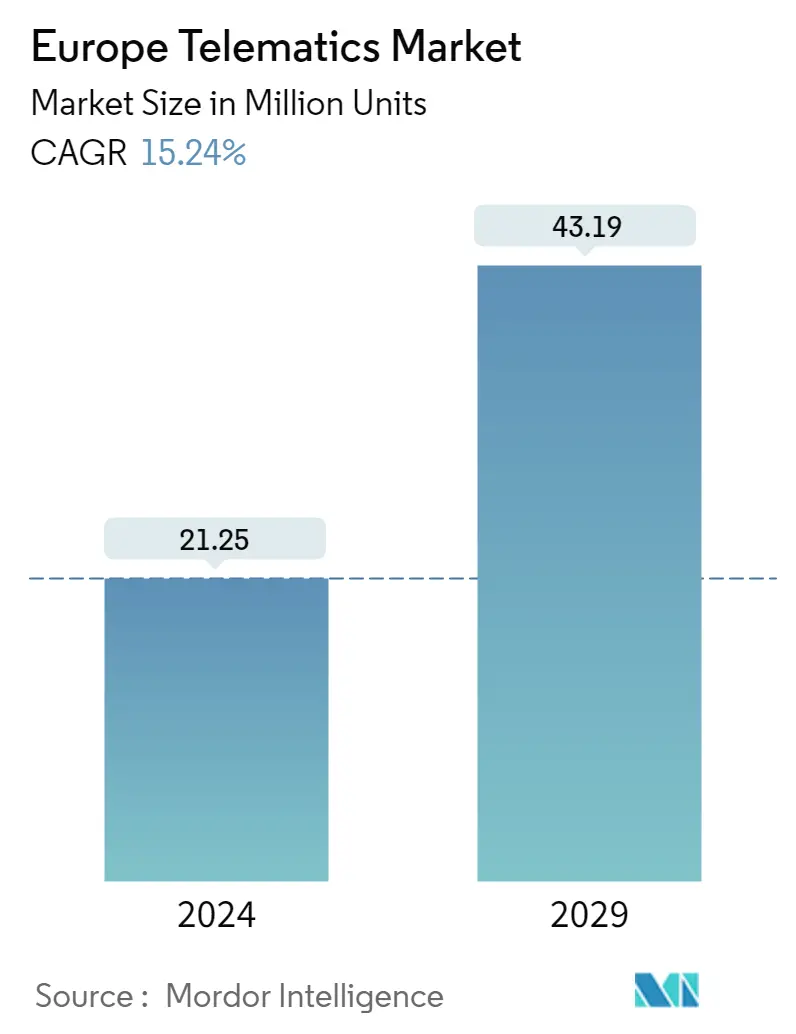Market Size of Europe Telematics Industry

| Study Period | 2019 - 2029 |
| Base Year For Estimation | 2023 |
| Forecast Data Period | 2024 - 2029 |
| Historical Data Period | 2019 - 2022 |
| CAGR (2024 - 2029) | 15.24 % |
| Market Concentration | Low |
Major Players
*Disclaimer: Major Players sorted in no particular order |
Europe Telematics Market Analysis
The Europe Telematics Market size is estimated at 21.25 Million units in 2024, and is expected to reach 43.19 Million units by 2029, growing at a CAGR of 15.24% during the forecast period (2024-2029).
- One of the primary drivers for market growth in the European region is the growing number of accidents. According to the European Commission, the rate of road deaths per million inhabitants in the European region was 46 in 2022. Several studies indicate that a significant portion of this is caused by heavy commercial vehicles. For instance, according to a National Library of Medicine survey, heavy goods vehicles are involved in 14.2% of fatal road crashes and 4.5% of police-reported road crashes in Europe.
- The demand for technology facilitating navigation, safety, and remote diagnostic is elevating the commercial as well as passenger vehicle space. The primary drivers of vehicle telematics include the European Union regulations, Local policy regulations, rise in the production number of automotive vehicles, coupled with small profit margins in the transportation industry. An expanding array of telematics devices and services, along with focused government mandates, will enable the technology to break into the mainstream.
- With telematics installed in vehicles, users can view their vehicle's location in real-time. This enables sending the ideal route for drivers to avoid traffic jams, delays, or accidents. It also helps increase the response times by choosing the vehicle that is closest to the customer location to deliver prompt and responsive service. In the case of businesses that deliver products, they can provide customers with a Tracking Link that assists them to view the location of the vehicle. This enables the customers to prepare in advance for the delivery.
- Although telematics technology has been used in many areas for decades, it is only in the last several years that it has become a phenomenon in fleet management. This technology combines telecommunications and informatics to uncover valuable insights into a fleet's operations. A fleet telematics system has two components: a device installed on fleet vehicles and software that collects, stores, and transmits information.
- The outbreak of the COVID-19 pandemic had a significant impact on the growth of the automotive industry in general, as the widespread lockdown and travel restrictions significantly impacted sales and demand in general. Several restrictions imposed regarding the use of a manual workforce also impacted the production capability of automotive manufacturers, who were also forced to either shut down their operations or continue with limited production capabilities, bringing a slowdown in the automotive industry.
Europe Telematics Industry Segmentation
Telematics refers to the set of technologies used to monitor a wide range of information concerning an individual vehicle or fleet. A Telematics system can gather information, including driver behavior, location, engine diagnostics, and vehicle activity, and help fleet operators to visualize the data generated on the software platform to manage their resources. The scope of the study includes the vehicle type, including passenger and commercial.
The Europe Telematics Market is segmented by Vehicle Type (Commercial (Current Market Scenario and Installed Base, Penetration of LCV vs. MCV/HCV, Telematics Service Revenue Analysis, Country (United Kingdom, Germany, France, Italy, Spain, Benelux, Norway, Sweden, Poland, Denmark, Finland, Rest of Europe)), Passenger Vehicle (Current Market Scenario and Installed Base of Embedded OEM Telematics Systems, and Region Analysis - Qualitative Analysis of Trends and Dynamics)). The market sizes and forecasts are provided in terms of the installed base of telematics systems for all the segments.
| Commercial | ||||||||||
| Current Market Scenario And Installed Base | ||||||||||
| Penetration Of Lcv Vs. Mcv/hcv | ||||||||||
| Telematics Service Revenue Analysis | ||||||||||
|
| Segmentation - By Passenger Vehicle | |
| Current Market Scenario And Installed Base Of Embedded Oem Telematics Systems | |
| Region Analysis - Qualitative Analysis Of Trends And Dynamics |
Europe Telematics Market Size Summary
The European telematics market is poised for significant growth, driven by the increasing need for enhanced vehicle safety and efficiency. The market is experiencing a surge in demand due to the rising number of road accidents, particularly involving heavy commercial vehicles, which has prompted stricter regulations and a focus on safety technologies. The integration of telematics in both commercial and passenger vehicles is being propelled by European Union regulations, local policies, and the need for improved fleet management systems. This technology, which combines telecommunications and informatics, is becoming essential for real-time vehicle tracking, navigation, and remote diagnostics, offering valuable insights that enhance operational efficiency across various industries, including logistics, construction, and public transport.
The market landscape is characterized by intense competition, with numerous players striving to capture market share through strategic partnerships and acquisitions. Key vendors such as Verizon Communications Inc., Webfleet Solutions BV, and Targa Telematics SpA are actively expanding their offerings and enhancing their technological capabilities. The growing e-commerce sector and the increasing production of light commercial vehicles in countries like the United Kingdom further contribute to the market's expansion. Despite challenges such as the high cost of telematics systems, the potential for cost savings in areas like fuel and insurance is encouraging more automotive manufacturers to adopt factory-fitted telematics solutions. As the market evolves, the introduction of value-added services and the integration of advanced connectivity features in vehicles are expected to drive further growth and innovation in the European telematics industry.
Europe Telematics Market Size - Table of Contents
-
1. MARKET INSIGHTS
-
1.1 Market Overview
-
1.2 Industry Value Chain Analysis
-
1.3 Industry Attractiveness - Porter's Five Forces Analysis
-
1.3.1 Bargaining Power of Suppliers
-
1.3.2 Bargaining Power of Buyers
-
1.3.3 Threat of New Entrants
-
1.3.4 Threat of Substitute Products
-
1.3.5 Intensity of Competitive Rivalry
-
-
1.4 Existing Policies and Norms
-
1.5 Key Operational Challenges of Fleet Managers in Europe
-
1.6 Assessment of the Impact of Macroeconomic Trends on the Industry
-
-
2. MARKET SEGMENTATION
-
2.1 Commercial
-
2.1.1 Current Market Scenario And Installed Base
-
2.1.2 Penetration Of Lcv Vs. Mcv/hcv
-
2.1.3 Telematics Service Revenue Analysis
-
2.1.4 By Country
-
2.1.4.1 United Kingdom
-
2.1.4.2 Benelux
-
2.1.4.3 Norway
-
2.1.4.4 Sweden
-
2.1.4.5 Poland
-
2.1.4.6 Denmark
-
2.1.4.7 Finland
-
2.1.4.8 Rest Of Europe
-
-
-
2.2 Segmentation - By Passenger Vehicle
-
2.2.1 Current Market Scenario And Installed Base Of Embedded Oem Telematics Systems
-
2.2.2 Region Analysis - Qualitative Analysis Of Trends And Dynamics
-
-
Europe Telematics Market Size FAQs
How big is the Europe Telematics Market?
The Europe Telematics Market size is expected to reach 21.25 million units in 2024 and grow at a CAGR of 15.24% to reach 43.19 million units by 2029.
What is the current Europe Telematics Market size?
In 2024, the Europe Telematics Market size is expected to reach 21.25 million units.

